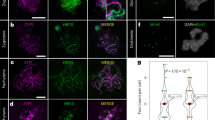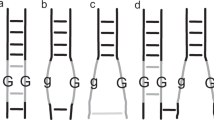Abstract
The diploid hybrid ryegrass, Lolium temulentum × L. perenne (2n = 14), contains two sets of chromosomes which are structurally and genetically dissimilar. Whole-mount surface spreading of synaptonemal complexes from 35 pollen mother cell nuclei shows that chromosome pairing during meiotic prophase is highly irregular, with homoeologues and heterologues pairing together to form multivalents. These are eliminated, however, during meiotic prophase in favour of homoeologous bivalents. In addition, the length differential between homoeologous chromosomes is accommodated in a coordinated fashion and is absorbed into the structure of the synaptonemal complexes. The hybrid thus displays a remarkable capacity to eliminate synaptonemal complex irregularities and to produce homoeologous bivalents, which are functionally and morphologically almost indistinguishable from their homologous counterparts in the parents.
Similar content being viewed by others
Article PDF
References
Abirached-Darmency, M, Cauderon, Y, and Zickler, D. 1984. Meiotic chromosome pairing in three Fl (Triticum-Secale) hybrids: A comparitive approach in light micro-scopy and electron microscopy. Biol Cell, 51 (3), 365–372.
Gillies, C B. 1987. The effect of Ph gene alleles on synap-tonemal complex formation in Triticum aestivum x T. kot-schyi hybrids. Theor Appl Genet, 74, 430–438.
Gillies, C B, Kuspira, J, and Bhambhani, R N. 1987. Genetic and cytogenetic analyses of the A genome of Triticum monococcum. IV. Synaptonemal complex forma-tion in autotetraploids. Genome, 29, 309–318.
Hobolth, P. 1981. Chromosome pairing in allohexaploid wheat var. Chinese Spring. Transformation of multivalents into bivalents, a mechanism for exclusive bivalent forma-tion. Carlsberg Res Commun, 46, 129–173.
Holm, P B. 1986. Chromosome pairing and chiasma formation in allohexaploid wheat, Triticum aestivum analysed by spreading of meiotic nuclei. Carlsberg Res Commun, 51, 239–294.
Holm, P B. 1988a. Chromosome pairing and synaptonemal complex formation in hexaploid wheat, monosomic for chromosome 5B. Carlsberg Res Commun, 53, 57–89.
Holm, P B 1988b. Chromosome pairing and synaptonemal complex formation in hexaploid wheat, monoisosomic and diisosomic for the long arm of chromosome 5B. Carlsberg Res Commun, 53, 111–113.
Holm, P B, and Wang, X. 1988. The effect of chromosome 5B on synapsis and chiasma formation in wheat, Triticum aestivum cv. Chinese Spring. Carlsberg Res Commun, 53, 191–208.
Hutchinson, J, Rees, H, and Seal, A G. 1979. An assay of the activity of supplementary DNA in Lolium. Heredity, 43, 411–421.
Jenkins, G. 1983. Chromosome pairing in Triticum aestivum cv. Chinese Spring. Carlsberg Res Commun, 48, 255–283.
Jenkins, G. 1985a. Synaptonemal complex formation in hybrids of Lolium temulentum x L. perenne (L.). I. High chiasma frequency diploid. Chromosoma, 92, 81–88.
Jenkins, G. 1985b. Synaptonemal complex formation in hybrids of Lolium temulentum x L. perenne (L.). II. Triploid. Chromosoma, 92, 387–390.
Jenkins, G. 1986. Synaptonemal complex formation in hybrids of Lolium temulentum x L. perenne (L). III. Tetraploid. Chromosoma, 93, 413–419.
Jenkins, G. 1988. Chromosome pairing in Lolium hybrids .In Brandham, P. E. (ed.) Kew Chromosome Conference III, HMSO, pp.261–267.
Jenkins, G, and Rees, H. 1983. Synaptonemal complex for-mation in a Festuca hybrid in Brandham, P. E. and Bennett, M. D. (eds) Kew Chromosome Conference II, Allen and Unwin, London, pp.233–242.
Jenkins, G, and Scanlon, M J. 1987. Chromosome pairing in a Lolium temulentum X L. perenne diploid hybrid with a low chiasma frequency. Theor Appl Genet, 73, 516–522.
Jenkins, G, White, J, and Parker, J S. 1988. Elimination of multivalents during meiotic prophase in Scilla autum-nalis. II. Tetraploid. Genome, 30, 940–946.
Loidl, J. 1986. Synaptonemal complex spreading in Allium. II. Tetraploid A vineale Can J Genet Cytol, 28, 754–761.
Moses, M J, and Poorman, P A. 1981. Synaptonemal com-plex analysis of mouse chromosomal rearrangements. II. Synaptic adjustment in a tandem duplication. Chromosoma, 81, 519–535.
Moses, M J, Poorman, P A, Roderick, T H, and Davisson, M T. 1982. Synaptonemal complex analysis of mouse chromosomal rearrangements. IV. Synapsis and synaptic adjustment in two paracentric inversions. Chromosoma, 84, 457–474.
Rasmussen, S W. 1977. Chromosome pairing in triploid females of Bombyx mori analysed by three-dimensional reconstructions of synaptonemal complexes. Carlsberg Res Commun, 42, 163–197.
Rasmussen, S W. 1987. Chromosome pairing in autotetraploid Bombyx males. Inhibition of multivalent correction by crossing over. Carlberg Res Commun, 52 (3), 211–242.
Rasmussen, S W, and Holm, P B. 1979. Chromosome pairing in autotetrapoid Bombyx females. Mechanism for exclusive bivalent formation. Carlsberg Res Commun, 44, 101–125.
Rees, H, and Jones, G H. 1967. Chromosome evolution in Lolium. Heredity, 22, 1–18.
Scanlon, M J. 1988. The manipulation of diploidizing genes in Lolium. Ph.D. Thesis, University of Wales.
Taylor, I B, and Evans, G M. 1977. The genotypic control of homoeologous chromosome association in Lolium temulentum X L. perenne interspecific hybrids. Chromosoma, 62, 57–67.
Wang, X. 1988. Chromosome pairing analysis in haploid wheat by spreading of meiotic nuclei. Carlsberg Res Commun, 53, 135–166.
Wang, X, and Holm, P B. 1988. Chromosome pairing and synaptonemal complex formtion in wheat-rye hybrids. Carlsberg Res Commun, 53, 167–190.
White, J, and Jenkins, G. 1987. Light and electron micro-scopy of the chromosomes of Hyacinthoides non-scripta (L.) Chouard ex Rothm. Caryologia, 40, 157–166.
White, J, Jenkins, G, and Parker, J S. 1988. Elimination of multivalents during meiotic prophase in Scilla autum- nalis I. Diploid and triploid. Genome, 30, 930–939.
Wischmann, B. 1986. Chromosome pairing and chiasma for-mation in wheat plants triisosomic for the long arm of chromosome 5B. Carlsberg Res Commun, 51, 1–25.
Author information
Authors and Affiliations
Rights and permissions
About this article
Cite this article
Jenkins, G., White, J. Elimination of synaptonemal complex irregularities in a Lolium hybrid. Heredity 64, 45–53 (1990). https://doi.org/10.1038/hdy.1990.6
Received:
Issue date:
DOI: https://doi.org/10.1038/hdy.1990.6
This article is cited by
-
The relationship between synapsis and recombination: two different views
Heredity (1999)
-
Lateral element lengths and nuclear disposition in Lolium
Heredity (1995)
-
Meiosis in autopolyploid Crepis capillaris
Chromosoma (1993)
-
Diploidisation ofLotus corniculatus L. (Fabaceae) by elimination of multivalents
Chromosoma (1990)
-
The fate of multivalents during meiotic prophase in the hybrid Gibasis consobrina x G. karwinskyana Rafin. (Commelinaceae)
Genetica (1990)



